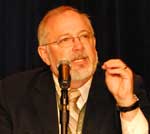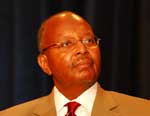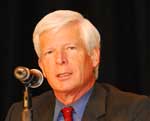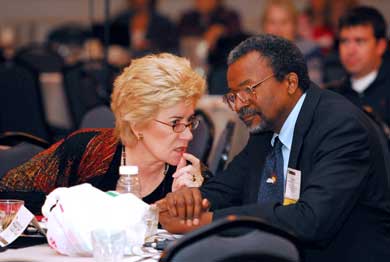| 
The Importance of Practice
 |
| Robert Glover, Ph.D. |
At every level—local, state, and national—regular
drills and tabletop exercises can help prepare staff
for the unexpected and avoid mass confusion in the face
of a crisis. Furthermore, conducting drills and exercises
helps people learn incident command structures and how
to get things done in the midst of chaos.
Robert Glover, Ph.D., said, "It's important to
take the time to prepare well before the disaster hits."
Dr. Glover, Executive Director, National Association
of State Mental Health Program Directors, joined in a
leadership panel with Dr. Wanser and Lewis Gallant, Ph.D.,
Executive Director, National Association of State Alcohol
and Drug Abuse Directors.
 |
| Lewis Gallant, Ph.D. |
Dr. Gallant and others emphasized the importance of
documentation during and after a disaster. That documentation
should include not only daily situation reports in the
emergency response center, but also lists of resources,
phone numbers, names, and written records of emergency
shelter services (e.g., medicines, counseling) to promote
continuity across shifts and throughout staff changeovers.
As a historical record, the information also provides
valuable guidance for workers responding to future disasters.
 |
| Dave Wanser, Ph.D. |
Presenters strongly encouraged conference participants
to familiarize themselves with the Federal National Response
Plan (NRP) and the National Incident Management System
(NIMS). Acronyms and other terms included in these documents
should be part of a disaster team's vocabulary, and the
NRP and NIMS should serve as procedural models for setting
up emergency response centers. (See Disaster
Readiness Resources article for links to the NRP
and NIMS.)
And for success at all levels, emergency response centers
should train staff and volunteer providers on field interventions
such as psychological first aid (see SAMHSA
News, Post-Disaster Response
article).
Back to Top
Top Regional Challenges
Regional coordination, planning, partnerships, and response
are complex processes and require the ability to navigate
interstate agreements, funding strategies, and licensing
issues. Specific challenges include obtaining adequate
supplies of medications such as treatments for opioid
dependency, psychotropic medications, and other pharmaceuticals.
One of the barriers cited was the lack of opportunities
for ongoing, face-to-face collaboration among disaster
planning teams in neighboring states. To improve basic
communications, recommendations included more Web-based
communications, such as listservs and bulletin boards.
As Federal, state, and local agencies; advocacy organizations;
consumer networks; peer support groups; and others continue
to work together, synergy is created.
"One of the things we've learned," said Ms.
Power, "is that no one agency is solely responsible
for a disaster response. Hurricane Katrina taught us
that more than anything. We need to draw on the strength
and resilience of the entire community to make this work."
 |
| A. Kathryn Power, Director of
SAMHSA's Center for Mental Health Services (left),
and Dr. H. Westley Clark (right), Director of SAMHSA's
Center for Substance Abuse Treatment, confer before
a joint conference presentation. |
More information on the "Spirit of Recovery"
conference, including PowerPoint presentations, is available
at www.spiritofrecoverysummit.com.
For more information on disaster readiness and response,
visit SAMHSA's Web site at www.samhsa.gov. 
Back to Top
Hurricane Survivors Share Their Stories
Survivors of hurricanes Katrina, Rita, and Wilma shared
their stories at SAMHSA's "Spirit of Recovery"
conference in New Orleans in May. After the opening plenary,
four survivors recounted their experiences during and
after the storms. Later in the conference, other survivors,
including Eartha Johnson, Ed.D., told their stories.
They were introduced to participants by Ann Herron,
M.S.W., SAMHSA Center for Substance Abuse Treatment,
and Anne Mathews-Younes, M.Ed., SAMHSA Center for Mental
Health Services.
Hubert "Bert" Jackson, Jr., M.A.:
"More than 22,000 families are still living in FEMA
trailers in this area," said Mr. Jackson. Working
for Project Recovery in the towns of Biloxi and Gulfport,
MS, he is part of the crisis counseling team that is
helping people recover from the devastation of Hurricane
Katrina throughout that area.
Maryann Powell: "I had to be that
solid rock for everybody," said Ms. Powell. "I
couldn't fall apart." A single mother of five, Ms.
Powell evacuated from New Orleans to Mississippi to ride
out Hurricane Katrina. But her odyssey didn't end there.
After a heartbreaking look at what was left of her home
back in New Orleans, she and her family traveled to Florida.
After Hurricane Wilma hit that state, Ms. Powell began
working for Project Hope, Florida's crisis counseling
program. "It helps to be helping," she said.
Ro’bin White Morton: "Water
was all about us," said Ms. Morton of her experience
in New Orleans after Hurricane Katrina. From the city's
17th Street Canal area, she made her way with her family
to the Superdome and then relocated first to Huntsville,
TX, and later to Philadelphia, PA. She now works for
Project Thrive's community-based program in Philadelphia.
"I'm grateful my family was spared," she said.
Michael Patrick: "Be safe, be
careful, and make a difference," said Mr. Patrick,
sharing some of the wisdom he has learned as an outreach
worker for Project Recovery in Mississippi. 
 |
| (L to r) Bert Jackson, Jr., SAMHSA’s
Anne Herron, Maryann Powell, SAMHSA’s Anne
Mathews-Younes, Ro’bin White Morton, and Michael
Patrick |
|
« See Part 1: Hurricane Recovery
Guides Preparedness Planning
See Also—Hurricane
Recovery Guides Preparedness Planning
Post-Disaster Response: Learning
from Research: Part 1 »
Post-Disaster
Response: Learning from Research: Part 2»
Schools Offer Stability for Children of Disasters »
Documentary Features New Orleans High School »
Disaster Readiness Resources »
See
Photo Gallery »
See Also—Next
Article »
Back to Top
|




